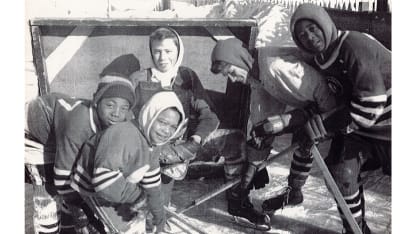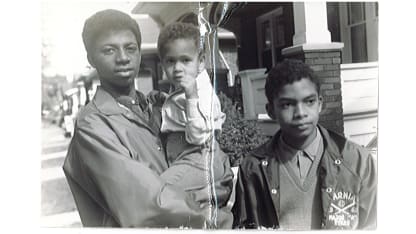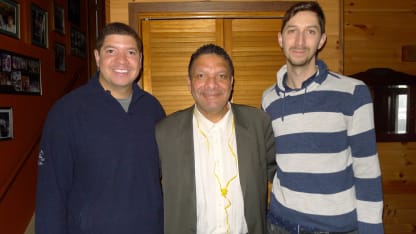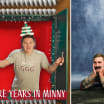Editor's note: As part of the NHL celebrating Black History Month throughout February, NHL.com will present first-person essays by some of the game's key Black players and executives. Today, Tony McKegney, the first Black player to score 40 goals in an NHL season, tells his story of overcoming racial bias and serving as inspiration for Jarome Iginla, the only other Black player to hit the 40-goal milestone.
Black History Month essay: Tony McKegney
First Black player to score 40 goals in an NHL season on overcoming bias, inspiring others

© Graig Abel/Getty Images
By
Tony McKegney / Special to NHL.com
There was nothing special about the goal. It barely made it over the line. I remember I was tired when a shot from the point came my way. It was a simple chip-in that just dribbled through the goalie's pads.
But I cherish everything about that goal that found my stick in the last minute of the last game of my 1987-88 season with the St. Louis Blues.
Because you never forget scoring 40 in one year.
It was a personal best for me -- the first and only time I'd join the NHL's 40-goal club. In retrospect, I can now see how it was an important milestone for people who look like me: No Black player had ever scored 40 goals in a season … not until that game against Winnipeg, where a little chip-in ended up making history.
Back in 1988, I'm not sure if I realized what it really meant. Still, I'd been thinking about that particular goal mark for a while. When the last road trip started, I thought about how meaningful it would be to end the season with a goal total that was a round number. Of course, I also thought about the bonus clause in my contract, which promised $15,000 if I happened to score 40 goals (that was a lot of money in those days).
So I found myself focused on a number, 40, throughout the last stretch of games. Hockey was like that for me -- I was constantly focused on numbers. Even now, when I tell the story of the 1987-1988 season, I use a lot of numbers to explain why the season turned out so special.
There were five centermen on that team who were great passers, and when you're playing with so many good centermen, you're going to get chances every game.
There were three future Hall of Famers who made us all better.
It was my 10th season in the League, and I'd gotten more comfortable over time.
Numbers, however, never tell the whole story. They're too neat; too objective. Reality doesn't always add up.
It certainly didn't add up when I was moving to St. Louis before the start of the season.
One house seemed perfect for me and my wife, Sue. We were all set to move, until the homeowner told us there was a problem: They didn't want to rent to us once they found out we were a biracial couple.
The subtext of the situation was clear: Because I'm a Black man, there were certain things the homeowner felt like I couldn't or shouldn't do. And I know they weren't alone in their thoughts. Previously, in the early '80s, one of my team's assistant coaches advised me to start dating a Black woman instead of Sue for similarly ignorant and bigoted reasons.
I ignored that coach, of course. And it wasn't hard to find a different place to live in St. Louis, which is a wonderful city that I've always enjoyed. But the homeowner's and the coach's comments were unwelcomed reminders that people were constantly viewing me through the lens of my race -- even when I just wanted to be a home renter, or a hockey player.
It can be difficult to talk about how those views affect you as a person. During my career, I know I tried my hardest not to think about them at all. My mindset was focused on maintaining a consistent level of play to succeed in the National Hockey League. Playing hockey at a high level is difficult enough without navigating the pressures of racism in society or figuring out how to respond to the supposed "fan" with a sign that says, "McKegney, grab a basketball" behind the Zamboni entrance.
So I did the only thing I could do: I focused on perseverance. I relied on the support of my teammates who were always there for me. And I followed the advice that the great Willie O'Ree has given so many times: channel your energy into lighting the red light.
I'd been chasing that red light since I started playing hockey at 3 years old. My mother and father -- who adopted me from an orphanage in Montreal, and who happen to be white -- built a hockey rink in our backyard every winter, where I'd skate with my siblings.

The McKegney brothers (l-r), Mike, Tony, Ian and friends on their backyard rink in Sarnia, Ontario in 1962.
At age 5, I started playing organized hockey. I always loved the game, but I didn't see myself reflected in it. In fact, I didn't play against another Black hockey player for nearly 18 years -- when Ray Neufeld, Grant Fuhr, and I were all active in the League.
I don't talk much about the taunts and racial slurs I faced in youth and minor hockey. People weren't used to seeing a Black player succeed on the ice. But I always wanted to be, and knew I could be, a dominant player. I just pushed the stereotypes to the background and kept hockey in the forefront.

Tony McKegney (front, second from r.) and his Sarnia Bees teammates of the Western Ontario Junior B Hockey League in 1973.
It's something that most Black players at the time trained themselves to do, even though we shouldn't have needed to.
Fast forward to 1987-88, and my performance in the NHL was helping to prove the stereotypes wrong. I remember starting the season with 10 goals in the first 15 games and getting a lot of ice time. Things just felt right that year.
By midseason, people started to notice. In February 1988, I was interviewed for an article called "Tony McKegney Makes His Mark in the NHL," where I talked about how the season was going and importance of role models.
I remember the reporter asking me about growing up in a town where there were only two Black families among 50,000 people. I said, "I think sports probably helped a lot, because we were known as athletes and so forth. People had a certain amount of respect for us athletically."

Tony McKegney (r.) with brothers Mike (l.) and Steve in front of their house in Sarnia, Ontario in 1970.
I was trying to convey something that I think is still true today: Sports can be the common denominator that brings people together. When you and your teammates compete together, practice together, eat together, and grow up together, you start to see people for who they are. You learn that what matters most is their work ethic, their commitment, their passion, their personality, maybe their sense of humor -- certainly not the way they look. Of course, sports will never make us color blind, and colorblindness is not the goal. The goal is to make stereotypes disappear by making people from all backgrounds feel welcome, celebrated, and empowered on an equal playing field. When sports are at their best, that's what they can do.
This is especially true for a sport like hockey, where community, respect, and teamwork have always been important values. The more hockey lives up to those ideals, the better we'll all be. Just like society as a whole, the hockey community still has a lot of hard work to do. It saddens me to hear the accounts of the current crop of Black players and other players of color that are still facing the same obstacles and ugly behavior that I encountered when I was their age. Hockey players like Akim Aliu, Mark Fraser, and Matt Dumba are just a few of the guys using their voice in meaningful ways. I feel for them all and support them unequivocally.
These brave athletes are actively changing hockey culture for the better. It's the kind of impact that wins, losses, and point totals can't capture. Like I said, numbers never tell the whole story.
There is one number, though, that says a lot about the season I had in 1987-88. It's not the 40 goals I scored. It's the number of Black players who have ever scored 40 goals in an NHL season.
Two.
The second person to achieve (and ultimately surpass) this milestone? Jarome Iginla.
Before Jarome was an NHL superstar and represented Canada in three Olympics, he was just like every other Canadian kid playing ball hockey in the school yard -- except he stood out for looking different than the 'typical' hockey player.
Clearly, Jarome recognized that the 'typical' hockey player could be anyone who loves the game and plays it well. Years later, I found out I was one of the reasons why. Jarome told me that he felt comfortable at the school yard because he could point to me and say, "Look, Tony McKegney's playing in the NHL."
Look, there's a Black player who did what some people said he couldn't. And if those people were wrong about his future in hockey, what else might they be wrong about?
I've always considered it a great compliment to play a small part in Jarome's story. If my career took some pressure off of him, or anyone who looks like us, I'm very proud of that. It's a big deal that Grant, Willie, and now Jarome have been inducted into the Hall of Fame. That is a great start and I am looking forward to rooting for the Black players drafted in the past few years who are going to carry on this legacy.
Throughout 15 years of professional hockey, I'm lucky enough to say that there are many moments I'm proud of. I'm certainly proud to have been one of the first consistent Black players in the NHL. And I'll always be proud of the 40-goal season I had in 1987-88, the wonderful camaraderie of that Blues team, and the little chip-in that somehow found its way into the net.

Tony McKegneny (c.) with his sons, Dan (l.), and Robert.

















